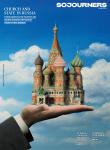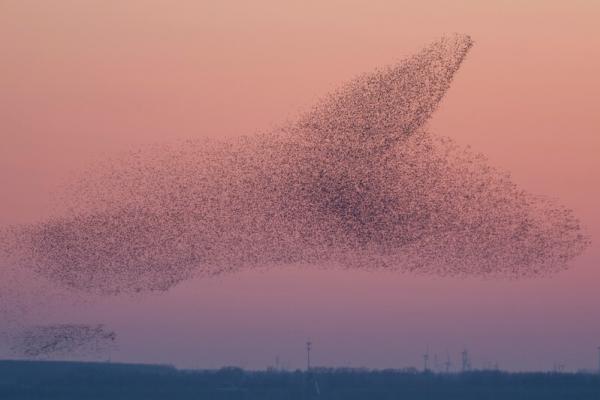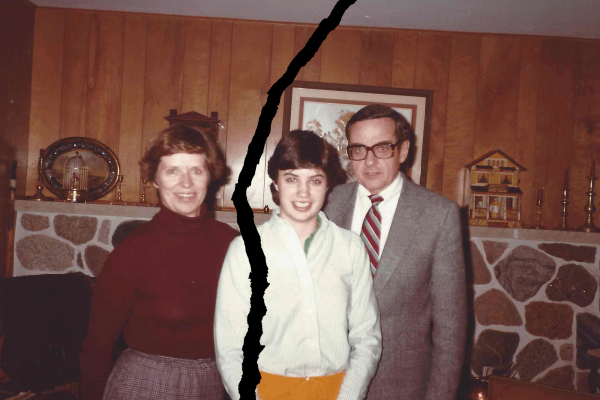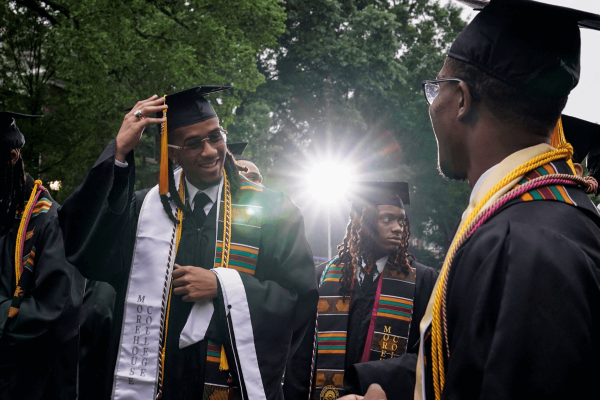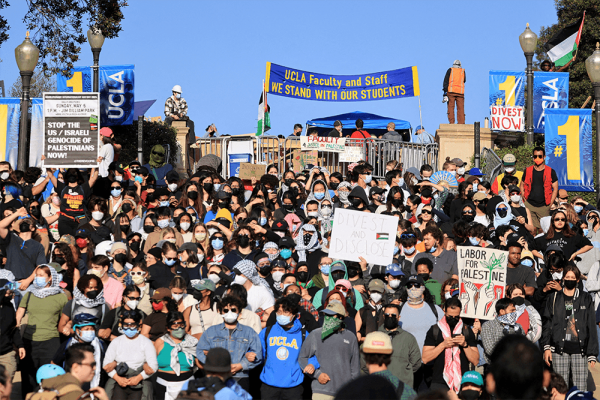I remember singing a children’s worship song in my Pentecostal church when I was around 10 years old:
It’s time to cross over.
It’s time to possess the land.
We’ll stand, lifting up Your praises.
Through this mighty army, we’ll bring revival to the land.
That memory — kids singing about spiritual warfare in church — was what flashed through my mind when I saw charismatic worshippers at the entrance of the Capitol building across from the Supreme Court on Jan. 3, 2021. I had just moved into the Capitol Hill neighborhood the day before. My new housemate and Twitter feed told me President Donald Trump's supporters were coming to town for a “Jericho march,” and I wanted to check out the scene. Under the guise that I was taking in my new surroundings (should I get confronted and asked), I observed them in the chilly, misty weather from afar.
It was a group of about 10 people; one or two had shofars blowing, a 20-something white woman was dancing in a pseudo-ballet style, and the rest were moving to an unrecognizable tune of some Hillsong or Bethel-esque worship anthem. I wanted to watch them, to see how the group would change and evolve over the few hours of daylight left. But I was concerned that I’d look a bit suspicious staring at this group for too long. So I continued my stroll.
Near the entrance of the Capitol building, between the two visitor centers, was a white man in his 50s, walking his German Shepherd and wearing a camouflage jacket. He was shouting angrily, accusing “the establishment,” of meddling with the presidential election votes, and also incoherent ramblings about former President Barack Obama’s “connection with the Chinese Communist Party.”
I looked at him, and then looked at the worshippers several yards away — the two scenes were threads from the same cloth. The man sounded aggressive and fearful; the worshippers carried themselves in a mystical, flowery manner that could leave an off-putting and eerie aura to the passerby, given the tense moment stirring in Washington. Their approaches seemed vastly different, yet, I’d assumed, they were all there for the same reason: because of the false belief that the election was stolen.
I stood thinking to myself until I saw a security guard making his rounds toward me.
“Getting crazy here, huh?” I asked him.
He replied, “Oh, it’s like any other day on the Hill.”
By Jan. 5, 2021, I started to see more red hats throughout my new neighborhood. Nearing the front of the Supreme Court, I saw American flags, Trump flags, and “Don’t Tread On Me” flags, of motley variations, all over First Street. I noticed a group forming at the Supreme Court and headed over. Roger Stone was speaking to those assembled. Stone’s speech wasn’t as eventful in my memory, but having a top figure in Trump’s world leading chants to “stop the steal” and insulting Washington’s mayor, Muriel Bowser, pumped up the crowd.
After Stone was finished, I observed two friends — who perhaps hadn’t seen each other in a while — embrace and share encouragements for the following day:
“We gotta stop the steal, man.”
“Yeah, we just gotta.”
I left the Supreme Court building feeling a dread and uncertainty of what was going to happen the next day.
Jan. 6: The Feast of the Epiphany. The day that marks the revelation of God’s incarnation in Jesus Christ. It was an important day in my family growing up. On “King’s Day,'' in Puerto Rican custom, children would go to the fields and pick grass to leave under their beds. By the next morning, the “Magi” would have already visited — leaving presents in lieu of grass, their camels well-fed from the grass for their journey to the next house.
On that day last year, I woke up late to headlines blaring that rioters “STORMED THE CAPITOL.” I put on clothes, shoes, and a coat and dashed over there.
As I got close, I saw a large “Jesus 2020” sign hanging from the brown garden bed on the right of the Capitol Building East. The iconic MAGA hats flooded the grounds. I strolled around and took a good look at the people who were there. I saw men covered in militaristic-looking gear. I saw teens walking around taking selfies and playing on their iPhones. I spoke with an adult son and elderly mother who were quickly departing to avoid any possible interactions with “antifa.” I heard what sounded like club music playing from large speakers. What struck me about this entire group was that they all felt familiar — like I had grown up surrounded by them my entire life. The Capitol Hill grounds felt like an insurrectionist-themed tailgate party. There were families along with extremists, children along with militants, and up-to-then average Joes and Josephines coupled with Proud Boys and not-so-average armed nationalists. Crosses, Trump flags, red hats all melded together to create a moment that — while denounced as “un-American” later on — felt as American as I remember growing up in a part of Virginia that loved God, guns, and confessional American patriotism. This milieu is as inseparable and intersectional as its more progressive counterpart.
Never had I felt so familial yet so distanced by an infinite chasm to these people, and to those back home, than in those moments on Capitol Hill on Jan. 6. It was a surreal, eerie space in time that hasn’t left me since.
This reverie was broken by a guy with red blowhorn who started taunting a reporter and cameraman in front of me. A group started to form as the journalists retreated behind a small metal fence where other members of the media stood. This group of harassers became increasingly large and hostile, shouting “Get outta here!” and unpublishable expletives. Finally, as if a dam broke, the crowds pushed the flimsy metal barriers aside and went after the camera crews and journalists. They assaulted the journalists, and it appeared that some of crowd broke their camera equipment in the process. Not long after the incident, I walked home, full of adrenaline and emotionally numb to everything that I just saw.
It’s now been a year since Jan. 6, 2021. I’m sitting in a neighborhood coffee shop with snow covering the cars and trees, feeling exhausted from a year of seemingly endless pandemic surges, political polarization that’s affected my relationships with few of my friends and family, and attempts to come to grips with the inescapable disillusionment that never fully left when I was on the Capitol building grounds that day.
In that time, I’ve returned to acknowledging that “spiritual warfare” is actually a vital part of my own faith. The progressive and leftish-leaning Christian folk I hang out with nowadays eschew militaristic language, metaphors, and terminology that even hints of one person causing physical harm to another. But in the realm of the Spirit, there are certainly ideas, values, and beliefs that leave the world slightly better off than before, and that are worth fighting for. And while certainly we can’t engage in any sort of physical struggle, I believe there are principalities and powers (and humans who embody these forces) who we must contend with through prayer, confrontation, and all the nonviolent tools at our disposal.
The friends, family and acquaintances of mine who’d been pro-Trump up to Jan 6. still haven't left Trumpism. Some of them still blame “antifa” or #BlackLivesMatter and want to forget about that day. A few others I know have joined the local school board to push back against the threats they see in COVID-19 safety measures and “critical race theory.” Across the country, those supportive of or sympathetic to the insurrection are running for local office and election boards to help prevent the pseudo-issue of “election fraud.” What Jan. 6 confirmed for me is that my junior-church teachers, pastors, and televangelists were actually correct: There really is a war going on.
I’m not much of a combative spirit, to be frank, and I’m certainly far too weary to muster all my energy to “fight the good fight.” In reflecting on King’s Day, it almost seems as if the wise men, in a simple way that was devoid of loud prayers in tongues, shofars, or elaborate dancing, conducted their own form of spiritual warfare. In the gospel, we read that after the wise men had left their gifts with the child Christ, they “left for their own country by another road” because they had “been warned in a dream not to return to Herod” who was out to destroy Jesus (Matthew 2:11-12). They couldn’t necessarily prevent Herod’s murder of the infants following their departure. Nevertheless, they helped foil Herod’s plot to murder the Christ child. Their weapon was to simply choose to go into another direction.
Got something to say about what you're reading? We value your feedback!


